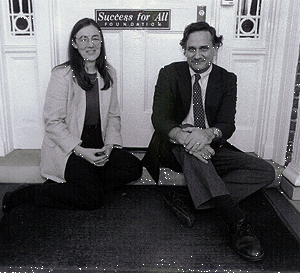
 An unprecedented Success
An unprecedented Success
Back in the late 1960s, when Robert Slavin and Nancy Madden were
undergraduates at Reed College in Portland, Ore., they used to
spend hours and hours talking about school reform.
"Ah, the 'walking in the rain' story," Madden
says with a slightly theatrical sigh as she and Slavin, her
husband, tell the story of Success for All, one of the
largest and most successful research-based school reform models
in the country today.
"We met in college, and yeah, we'd walk around
in the rain and talk about our school reform," she explains. "We
got our first grant in 1970, one summer during college, and we
hired a staff and we developed the core of World Lab, which is
still part of the program now. It was a science and social
studies-based curriculum designed to actively engage kids not
achieving in school."
Full story...
 Human embryonic stem cells
cultured
Human embryonic stem cells
cultured
A team of scientists has isolated and identified human stem cells
and proved them capable of forming the fundamental tissues that
give rise to distinct human cells such as muscle, bone and nerve.
This feat has for decades been one of basic science's holy
grails, and while scientists have found stem cells in mice and
higher animals, this is believed to be the first time researchers
have cultured human embryonic stem cells.
"The potential of these unique, versatile cells
for human biologic studies and medicine is enormous," says John
Gearhart (pictured at right), a professor of
obstetrics/gynecology and of physiology, who led the mostly
Hopkins research team. "These cells will rapidly let us study
human processes in a way we couldn't before. Instead of having to
rely on mice or other substitutes for human tissues, we'll have a
unique resource that we can start applying to medicine."
Full story...
 APL-developed device takes John Glenn's
temperature in space
APL-developed device takes John Glenn's
temperature in space
It came from space, and now it's returned to space--that's the
strange itinerary of a unique device that lies in John Glenn's
belly continuously taking his temperature as he orbits the Earth
aboard space shuttle Discovery.
As part of his medical experiments,
Senator/astronaut Glenn swallowed a 3/4-inch-long,
silicone-coated capsule that contains a tiny telemetry system, a
microbattery and a quartz temperature sensor. These devices had
their roots in the work of spacecraft scientists at the Applied Physics Laboratory as
they invented Transit, the world's first navigation-by-satellite
system, more than three decades ago.
Later, when APL biomedical scientists, working
on a shoestring $75,000 NASA grant, were asked to develop a
device that could be swallowed by astronauts as a way to measure
their core body temperature, they borrowed technology from their
space colleagues to invent the ingestible temperature capsule.
Full story...
| [ The Gazette | Search | About the Gazette | Send us Email ] |
The Gazette
 The Johns Hopkins University
The Johns Hopkins University
 Suite 100
Suite 100

3003 North Charles Street
 Baltimore, Maryland 21218
Baltimore, Maryland 21218
 (410) 516-8514
(410) 516-8514  gazette@resource.ca.jhu.edu.
gazette@resource.ca.jhu.edu.
